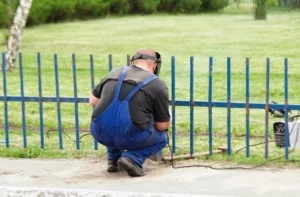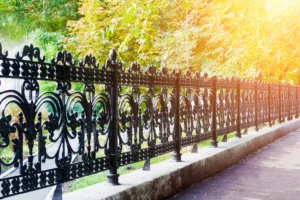Choosing between a cedar and a vinyl fence is a typical dilemma for homeowners looking for the best combination of appearance, durability, and affordability. Both materials have distinct advantages and disadvantages that appeal to varying demands and tastes. Cedar, noted for its natural beauty and resilience to decay, is popular among individuals who respect traditional craftsmanship and environmental friendliness.
Vinyl fences, on the other hand, provide unrivaled endurance, little maintenance, and a modern aesthetic, making them a popular choice for individuals who value simplicity and durability. Understanding the unique properties of each material is critical in making an informed selection that meets your individual fence requirements.
Appearances

Which fence is the right one for you?
Any home’s inherent beauty is enhanced by the rustic, natural appeal of cedar. This kind of wood fence is a traditional choice for a natural blend because of its distinctive grain patterns and deep tones. This cloth weathers into a chic gray tone that enhances the appeal of any space. On the other hand, vinyl fences have a sleek, modern appearance and are available in a variety of designs and colors. Its ability to mimic the appearance of wood without the flaws attracts those looking for a smooth, homogeneous appearance. Because of its resilience to fading, the fence is a great low-maintenance option for modern aesthetics because it will remain colorful and striking for many years.
- Environmental Considerations
In terms of environmental impact, cedar fences outperform vinyl fences. Cedar is a renewable resource that degrades over time, minimizing its influence on landfills. Its manufacturing technique involves minimum processing, resulting in decreased energy use and carbon emissions. Furthermore, properly sourced wood is frequently certified by sustainable forestry programs, ensuring it originates from well-managed forests. Vinyl, on the other hand, is made up of a fossil fuel-derived material known as polyvinyl chloride (PVC). Its manufacturing process emits toxic chemicals and consumes a lot of energy, which contributes to environmental degradation. Furthermore, vinyl is not biodegradable and can survive in landfills for generations. As a result, cedar is widely regarded as the greener choice among ecologically aware customers.
- Maintenance
Vinyl and cedar fences are equally attractive and durable, but they demand quite different levels of upkeep. Because cedar is natural, it should be maintained occasionally to maintain its beauty and lifespan. This involves sealing to guard against weathering, insect damage and rotting. Cedar fences may also require periodic pruning or trimming in order to maintain their form. On the other hand, vinyl choices need relatively little maintenance. They only require a simple wash with soap and water to keep their best appearance since they are resistant to deterioration, insects, and fading. They offer an ideal alternative for many homes despite not having the same natural warmth as cedar fences due to their minimal maintenance requirements.
- Sturdiness
Both can offer a strong barrier, but they are different when it comes to their robustness and lifespan. The inherent resilience and strength to deterioration of cedar are well known. It is shielded by its thick grain and high oil content against insect damage and deterioration. To maintain their structural stability and look over time, they may require routine care like staining and sealing. Conversely, vinyl is a man-made substance with remarkable resilience as it is resistant to decay, dampness, and insects. Hollow cores are frequently used for reinforcement to provide them more stiffness and strength. Vinyl is a popular option for many homes because of its simplicity of upkeep and longevity.
- Cost
Fences made of wood and plastic cost much different. Because cedar is sometimes less expensive up front, it is a good substitute for people on a tight budget who want a natural wood look. To maintain its durability and appeal, nevertheless, it requires ongoing maintenance like staining or sealing, which might raise long-term costs. Conversely, installing a vinyl fence costs more but requires less maintenance. Because they are resistant to insects, weathering, and decay, they require little to no upkeep after they are built. With time, these lower maintenance costs might make it more affordable than wood. Whether you choose long-term savings with little upkeep or a lower initial investment will determine which of these two solutions is best for you.
When deciding between a vinyl and cedar fence, it all usually comes down to personal needs and tastes. Cedar fences are highly customizable and have a timeless natural beauty, but they must be maintained regularly to remain intact. While PVC is long-lasting, easy to maintain, and available in a number of forms, it may lack the natural beauty of wood. You may select the ideal material for your home by considering variables like as visual appeal, maintenance needs, and long-term cost to ensure it satisfies both practical and aesthetic standards.




